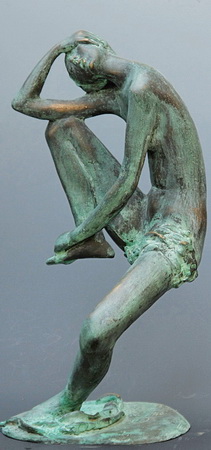|

|
|
Sculpture "Waiting" by Zhu Zhiwei from the Mufu Hill Art District in Nanjing. [Global Times] |
With the burgeoning of China's contemporary art market, a variety of art districts have emerged across the country, a stark contrast to 1995, when artists at the Yuanmingyuan Artist Village were ousted by local government officials.
This year's Songzhuang Cultural and Arts Festival, running from September 20 to October 12, presents artworks from different artistic districts nationwide. The exhibition, titled, "Community! Community!" presents for the first time a panoramic view of art colonies across the country.
Artists from ten different art zones in Nanjing, Chengdu, Xi'an, Wuhan and Changsha were invited to display their artworks. Each art district has a separate location at the festival, featuring recently created artworks by artists representing each community.
Thirteen large-scale art museums and galleries, such as the Songzhuang Art Museum, Sunshine International Art Museum, and the LDX Contemporary Art Center, provide exciting exhibits.
"There has been huge progress compared to fifteen years ago when the Yuanmingyuan artists' lifestyle was considered unacceptable to most ordinary people," said art critic Li Xianting. "Nowadays, we have so many artist villages and artistic districts blossoming across the country, the artists are living and working as part of local neighborhoods."
Li himself has been highly acclaimed as the "Godfather of Chinese contemporary art" for his tremendous contributions to its development over the past twenty years. He is also an eyewitness of the development of all art districts across the country.
In 2000, Li moved to Songzhuang, a town in Tongzhou District in east Beijing, where artists had settled in twos and threes since they were scattered from the Yuanmingyuan Artist Village. In addition to Songzhuang, several other art colonies in other parts of Beijing, such as 798 Factory, Feijiacun and Caochangdi, have become magnets for new artists, art collectors and tourists.
Nowadays, Songzhuang is widely referred to as "the biggest artistic district in China", with more than 2,000 artists at work in their studios. Instead of battling with local police and government officials, Songzhuang artists now enjoy artistic freedom, Li said.
Yi Ling, a famous artist who once lived in the Yuanmingyuan artist village, has deep impressions of changing attitudes toward art colonies. He's been named "head of the art villagers" for his enthusiasm in helping other artists to settle there.
"Fifteen years ago, artists in the Yuanmingyuan artist village drew attention from the police because of the artists' uninhibited lifestyle," he said. Even a small party with a few artists could trigger a full alert by the local police. A policeman on duty during the art festival's opening ceremony said that nowadays, "We won't interfere with the artists enjoying themselves. "We are here to protect the visitors in case of danger."
Many artists are chasing their dreams of creative expression in China's art zones. Many have given up their "iron rice bowl," a term that refers to an occupation with guaranteed job security, steady income and benefits, once the dream of almost all Chinese people.
Instead of harassment, artists in Songzhuang now enjoy conveniences provided by the local government. The town has sponsored the annual Songzhuang Cultural and Arts Festival, initiated in 2005. And the Songzhuang Art Promotion Association has also been providing services to artists since 2005. "We are trying our best to hold a festival with high academic standards, and thus offer more opportunities for artists to show their artworks," said Hong Feng, head of the association.
Although in the eyes of many art critics and artists, the involvement of official organization is a hindrance to artistic innovation, it has helped improve the living conditions of many artists.
(Global Times September 21, 2009)